Install the app
How to install the app on iOS
Follow along with the video below to see how to install our site as a web app on your home screen.
Note: This feature may not be available in some browsers.
You are using an out of date browser. It may not display this or other websites correctly.
You should upgrade or use an alternative browser.
You should upgrade or use an alternative browser.
WW II pommittajat !
- Viestiketjun aloittaja Juke
- Aloitus PVM
tulikomento
Supreme Leader
Ikarus
Respected Leader

"Hermosaha" -pilotteja kuvassa.
wikistä:
Toisessa maailmansodassa konetta käytettiin yöpommittajana; saksalaiset kutsuivat konetta "ompelukoneeksi" sen äänen perusteella. Myös nimitys "hermosaha" oli käytössä.
Erityisen kuuluisaksi konetyyppi tuli Neuvostoliiton vain naisista koostuvan 588. yöpommituslentorykmentin käytössä. Rykmentti teki häirintäpommituslentoja aivan rintaman läheisyydessä olevilta kentiltä. Pienen pommikuorman vuoksi lentoja tehtiin mahdollisimman monta - jopa 18 lentoa yhden yön aikana lentokonetta ja miehistöä kohti.
Yöpommituksissa kone lennettiin matalalennossa muutaman metrin korkeudessa. Kohdetta lähestyttäessä kone vedettiin ylös, moottori pysäytettiin ja kohdetta lähestyttiin äänettömästi liitäen yön pimeydessä. Jotkut yksikön lentäjät tekivät yli 1 000 taistelulentoa sodan aikana.
Sepeteus
Kapteeni

"Hermosaha" -pilotteja kuvassa.
wikistä:
Toisessa maailmansodassa konetta käytettiin yöpommittajana; saksalaiset kutsuivat konetta "ompelukoneeksi" sen äänen perusteella. Myös nimitys "hermosaha" oli käytössä.
Erityisen kuuluisaksi konetyyppi tuli Neuvostoliiton vain naisista koostuvan 588. yöpommituslentorykmentin käytössä. Rykmentti teki häirintäpommituslentoja aivan rintaman läheisyydessä olevilta kentiltä. Pienen pommikuorman vuoksi lentoja tehtiin mahdollisimman monta - jopa 18 lentoa yhden yön aikana lentokonetta ja miehistöä kohti.
Yöpommituksissa kone lennettiin matalalennossa muutaman metrin korkeudessa. Kohdetta lähestyttäessä kone vedettiin ylös, moottori pysäytettiin ja kohdetta lähestyttiin äänettömästi liitäen yön pimeydessä. Jotkut yksikön lentäjät tekivät yli 1 000 taistelulentoa sodan aikana.
Saksalaiset antoivat 588:lle lempinimen "Nachthexen" ("yön noidat | yönoidat")
osin siksi koska pääasiallisena lentokalustona naisilla oli puurakenteinen 115hp moottorilla varustettu PO-2 (muistuttaa kieltämättä luutaa jotenkin). Joka oli yllättäen pelottava vastustaja saksalaisille. Naiset lensivät öisin saksalaisten selustassa hyvin hiljaa ja hyvin matalalla, "häiriten" tehokkaastikin huoltoyksiköitä yms.
tulikomento
Supreme Leader
Vähän OT mutta yön noidista on tehty ihan pätevän oloinen neuvostoelokuva 80-luvun alkupuolella.
Hankin dvd:nä joitain vuosia sitten itänaapuriin suuntautuneelta reissulta. Ilman tekstitystä juoni jää aika lailla hämärän peittoon. Mutta plussana sangen näyttäviä lentokohtauksia aidoilla Po-2:lla.
Ja tältä se on varmaan näyttänyt saksalaisen jv-miehen näkövinkkelistä kun "ompelukoneet" iskevät kimppuun keskellä yötä.
Hankin dvd:nä joitain vuosia sitten itänaapuriin suuntautuneelta reissulta. Ilman tekstitystä juoni jää aika lailla hämärän peittoon. Mutta plussana sangen näyttäviä lentokohtauksia aidoilla Po-2:lla.
Ja tältä se on varmaan näyttänyt saksalaisen jv-miehen näkövinkkelistä kun "ompelukoneet" iskevät kimppuun keskellä yötä.
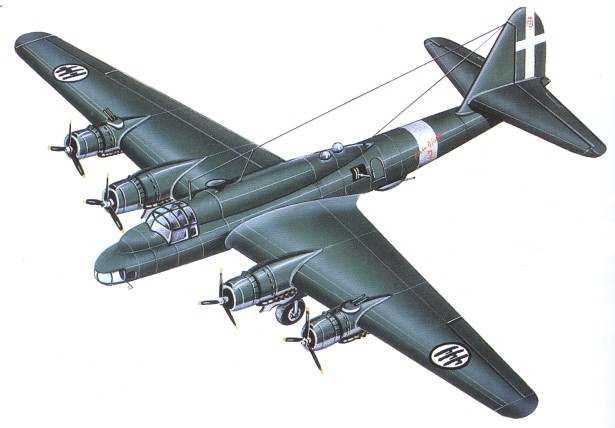

https://en.wikipedia.org/wiki/Piaggio_P.108
http://www.dieselpunks.org/profiles/blogs/s-a-m-83-italian-flying-fortress
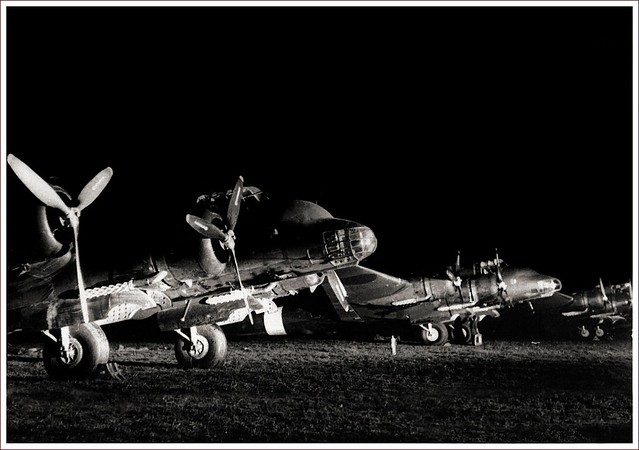
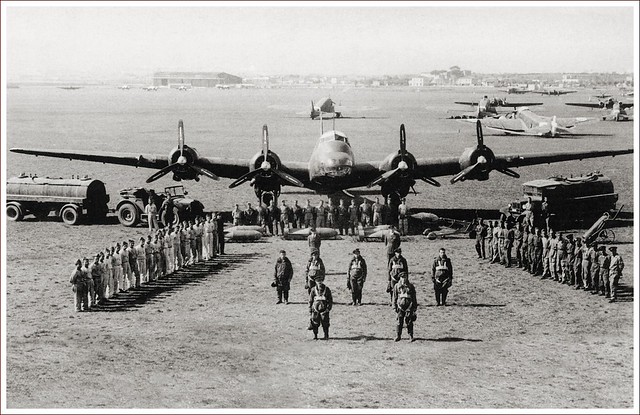
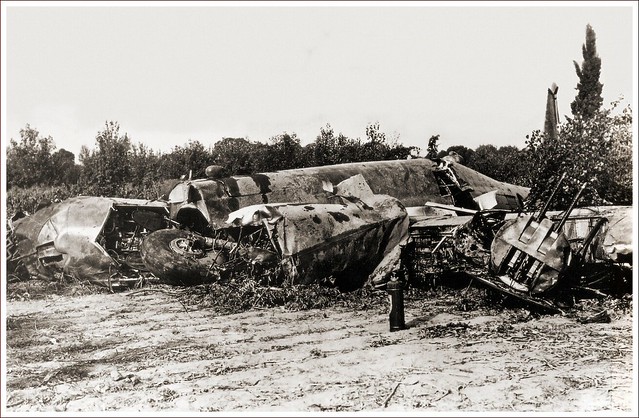
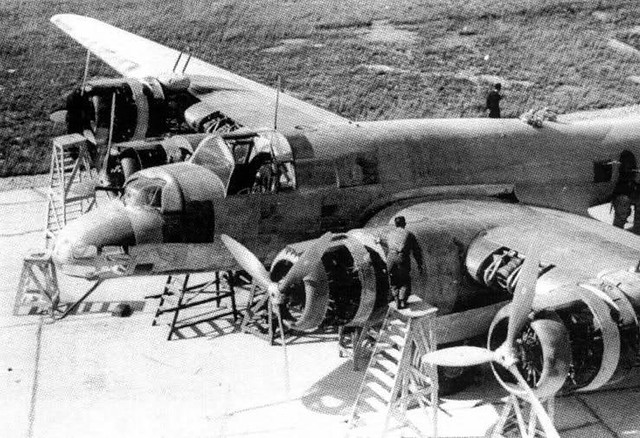
(P.XII R.C.35)

https://en.wikipedia.org/wiki/Piaggio_P.XII
Tuossa olisi ollut Myrskyyn moottori.
Mutta Fiat G 50 moottoreista huonojen kokemusten vuoksi, moottoreita ei edes kysytty italiasta.
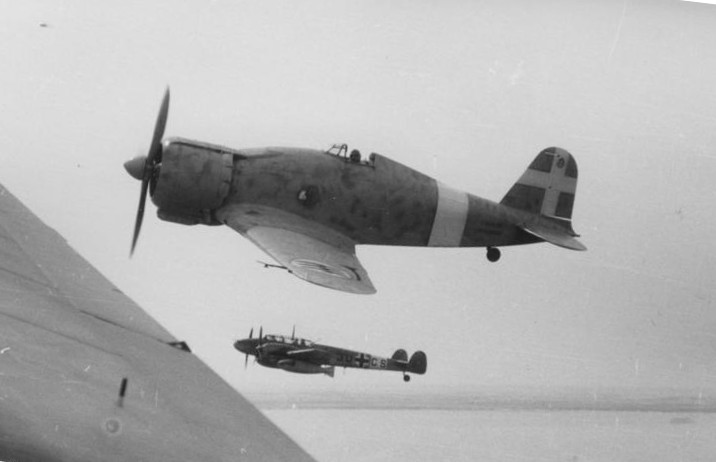
tulikomento
Supreme Leader
Fokker C X eli Frans-Kalle on varmasti yksi ilmavoimien sotakonekaluston suuria tuntemattomia.
Vaikka tyyppi olikin 30-luvun alun suunnittelua, oli se meillä vielä talvisodan aikoihin ihan kelpo peli. Toki olihan se liemessä neukkuhävittäjien sattuessa vastaan. Näillä suoritettiin tiedustelua ja häirintäpommituksia. Myös syöksypommituksia pienempiä pistemaaleja vastaan lennettiin, vaikka jostain Ju 87 Stukan potentiaalista jäätiin kauas.
Kertoo paljon ilmavoimien materiaalisesta tilasta, että Frans-Kallet pysyivät rintamakäytössä aina Lapin sotaan asti. Murheellista kyllä, myös Marskin ritari Paavo Kahla sai FK:lla surmansa syksyllä 44 saksalaisen ilmatorjunnan uhrina. Vielä 50-luvulle saakka koneella lennettiin maalinhinauslentoja.
Jos minulta kysytään, niin kotimaisten ilmailumuseoiden yksi suurimpia puutteita on FK:n puuttuminen kokoelmista. Tämä kun nyt oli ihan oikeasti merkittävä tyyppi meillä. Tiettävästi yhtään yksilöä ei ole säästynyt jälkipolville asti. Hollannista on vuosien mittaan kuulunut huhua, että siellä oltaisiin tekemässä replikaa, mutta tiedä häntä. Valmista ei ole tullut, tietääkseni.
Tikkakoskelta löytyisi tämän mukaan lähtökohdiksi kolmen C X:n rungot. Pirunmoinen ja kallis urakkahan tuollaisen täydellinen restaurointi varmasti olisi, mutta toivon mukaan ehkä vielä jonain päivänä...
http://axis.classicwings.com/

Vaikka tyyppi olikin 30-luvun alun suunnittelua, oli se meillä vielä talvisodan aikoihin ihan kelpo peli. Toki olihan se liemessä neukkuhävittäjien sattuessa vastaan. Näillä suoritettiin tiedustelua ja häirintäpommituksia. Myös syöksypommituksia pienempiä pistemaaleja vastaan lennettiin, vaikka jostain Ju 87 Stukan potentiaalista jäätiin kauas.
Kertoo paljon ilmavoimien materiaalisesta tilasta, että Frans-Kallet pysyivät rintamakäytössä aina Lapin sotaan asti. Murheellista kyllä, myös Marskin ritari Paavo Kahla sai FK:lla surmansa syksyllä 44 saksalaisen ilmatorjunnan uhrina. Vielä 50-luvulle saakka koneella lennettiin maalinhinauslentoja.
Jos minulta kysytään, niin kotimaisten ilmailumuseoiden yksi suurimpia puutteita on FK:n puuttuminen kokoelmista. Tämä kun nyt oli ihan oikeasti merkittävä tyyppi meillä. Tiettävästi yhtään yksilöä ei ole säästynyt jälkipolville asti. Hollannista on vuosien mittaan kuulunut huhua, että siellä oltaisiin tekemässä replikaa, mutta tiedä häntä. Valmista ei ole tullut, tietääkseni.
Tikkakoskelta löytyisi tämän mukaan lähtökohdiksi kolmen C X:n rungot. Pirunmoinen ja kallis urakkahan tuollaisen täydellinen restaurointi varmasti olisi, mutta toivon mukaan ehkä vielä jonain päivänä...
http://axis.classicwings.com/

Fokker C X eli Frans-Kalle on varmasti yksi ilmavoimien sotakonekaluston suuria tuntemattomia.
Vaikka tyyppi olikin 30-luvun alun suunnittelua, oli se meillä vielä talvisodan aikoihin ihan kelpo peli. Toki olihan se liemessä neukkuhävittäjien sattuessa vastaan. Näillä suoritettiin tiedustelua ja häirintäpommituksia. Myös syöksypommituksia pienempiä pistemaaleja vastaan lennettiin, vaikka jostain Ju 87 Stukan potentiaalista jäätiin kauas.
Kertoo paljon ilmavoimien materiaalisesta tilasta, että Frans-Kallet pysyivät rintamakäytössä aina Lapin sotaan asti. Murheellista kyllä, myös Marskin ritari Paavo Kahla sai FK:lla surmansa syksyllä 44 saksalaisen ilmatorjunnan uhrina. Vielä 50-luvulle saakka koneella lennettiin maalinhinauslentoja.
Jos minulta kysytään, niin kotimaisten ilmailumuseoiden yksi suurimpia puutteita on FK:n puuttuminen kokoelmista. Tämä kun nyt oli ihan oikeasti merkittävä tyyppi meillä. Tiettävästi yhtään yksilöä ei ole säästynyt jälkipolville asti. Hollannista on vuosien mittaan kuulunut huhua, että siellä oltaisiin tekemässä replikaa, mutta tiedä häntä. Valmista ei ole tullut, tietääkseni.
Tikkakoskelta löytyisi tämän mukaan lähtökohdiksi kolmen C X:n rungot. Pirunmoinen ja kallis urakkahan tuollaisen täydellinen restaurointi varmasti olisi, mutta toivon mukaan ehkä vielä jonain päivänä...
http://axis.classicwings.com/
Katso liite: 6533

tulikomento
Supreme Leader
Mainio kirja. Myös legendaarinen Joppe Karhunen on tuotannossaan käsitellyt Fokker C X:llä lentäneiden miesten vaiheita. Sitten on vielä Laus-Dei Saxellin muistelmateos Sotataivaan hiljaiset. Kyseinen mies aiheutti muuten vuosituhannnen vaihteessa pienoisen kohun väittämällä saaneensa käskyn pommittaa Äänisjärven kulttuurihistorialliset Kizhin saaren puukirkot päreiksi.
Saxell jätti väitteensä mukaan käskyn täyttämättä ja näin ollen kirkot olisivat säästyneet. Tätä stooria eivät muuten lentäjäveljet nielleet.
http://www.virtualpilots.fi/hist/WW2History-KishinKirkot.html
JR49
Respected Leader
Short Sunderland oli yksi suosikeistani Korkkareissa. Viimeiset mallit olivat jo niin vahvasti aseistettuja, että yksi piti 1943 puoliaan kahdeksaan JU-88:a vastaan, ja ampui niistä kolme alas! Tosisotilaita siinä lentoveneessä.
Olen lihavoinut muutaman kiintoisan yksityiskohdan. Muun muassa sillä oli vaikea laskeutua veteen muualla kuin rannikkoalueilla. Wiki tietää kertoa, että avomerellä kyllä pelastettiin koneella väkeä, mutta että jossain vaiheessa se olisi ollut jo kiellettyä.
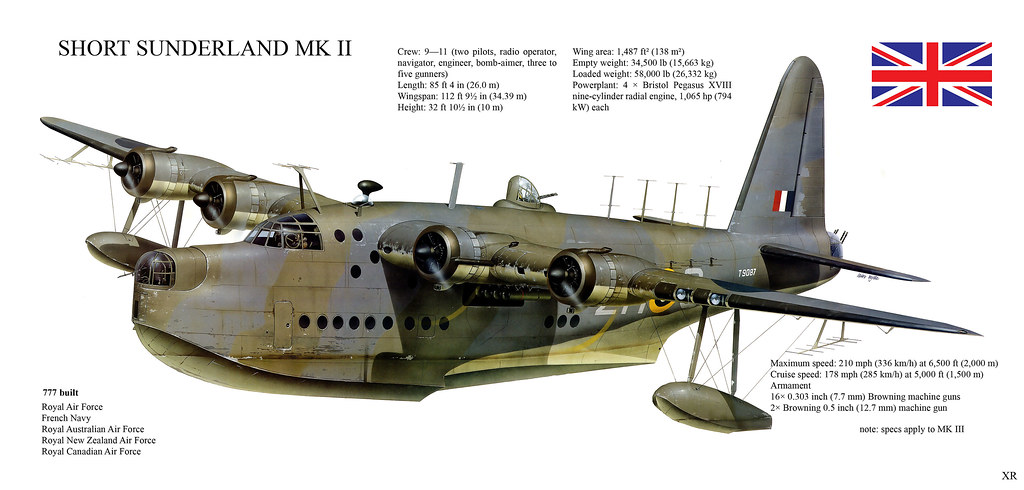
Tässä tuosta kuuluisasta ilmataistelusta. Lopusta voi lukea, kuinka kävi sitten kaksi kuukautta myöhemmin...
The rifle calibre .303 guns lacked hitting power but the Sunderland's defensive armament was nonetheless formidable. The aircraft's capacity to defend itself was demonstrated in an air battle between eight Junkers Ju 88C long range heavy fighters and a single Sunderland Mark III of No. 461 Squadron RAAF on 2 June 1943. This was one of several stories of the type's operations related by author Ivan Southall, who flew in Sunderlands during the war.[14] There were 11 crewmen on board the Sunderland: nine Australians and two British.[N 1] The aircraft was on an anti-submarine patrol and also searching for remains of BOAC Flight 777, an airliner that had left Lisbon the day before and had subsequently been shot down over the Bay of Biscay, killing 17, among them, the actor Leslie Howard. In the late afternoon, one of the crew spotted the eight Ju 88s. Bombs and depth charges were dumped and the engines brought to maximum power. Two Ju 88s made passes at the flying boat, one from each side, scoring hits and disabling one engine while the Sunderland went through wild "corkscrew" evasive manoeuvres. On the third pass, the dorsal turret gunner shot down a Ju 88. Another Ju 88 disabled the tail turret, but the next one that made a pass was hit by both the dorsal and nose turrets and shot down. Another destroyed the Sunderland's radio gear, wounding most of the crew to varying degrees and mortally wounding one of the side gunners. A Ju 88 tried to attack from the rear, but the tail turret gunner had regained some control over the turret and shot it down. The surviving Ju 88s continued to attack, but the nose gunner damaged one of these, setting its engines on fire. Two more of the attackers were also hit and the final pair disengaged and departed, the only two to make it back to base[citation needed]. The Sunderland had been heavily damaged. The crew threw everything they could overboard and nursed the aircraft back to the Cornish coast, where pilot Colin Walker managed to land and beach the aircraft at Praa Sands. The crew waded ashore, carrying their dead comrade, while the surf broke the Sunderland up. Walker received the Distinguished Service Order and several of the other crew members also received medals. With the exception of Walker, the crew returned to Sunderlands - they disappeared without trace over the Bay of Biscay two months later after reporting that they were under attack by six Ju 88s.

Short Sunderland
prepared by Emmanuel Gustin
To meet requirement R.2/33 of the Air Ministry for a general reconnaissance flying boat, Short developed the S.25 Sunderland from their famous S.23 "Empire" or "C-class" flying boat, the flagship of Imperial Airways. The S.25 first flew on 16 October 1937.
The Sunderland had a deep hull, and the wings were set high on the fuselage, to keep the engines and propellers away from the water spray. For the time, its size was very impressive. The hull had a single step, which served to break the suction of the water, and allow the flying boat to unstick. The characteristic blunt nose contained a two-gun turret, and the tail a four-gun turret. To correct a problem with the center of gravity, the wings were given a slight sweepback; the result was that the engines were slightly toed out. This cost some engine efficiency, but an advantage was that it improved controllability with one engine out. The stabilizing floats under the wing tips were attached by two struts and wire-bracing. On the water the aircraft was steered by canvas drogues, which were deployed through the galley windows.
The Sunderland was a pure flying boat, and if it had to be brought on shore special beaching wheels had to be fitted. Usually the Sunderlands were moored to a buoy. For this purpose, the front gun turret was rolled back and a chain was ran out. An anchor was on board, too. Daily maintenance was performed while the aircraft was moored. Supplies, fuel and ammunition were brought by boats, and some care was required to avoid damaging the hull. It was not uncommon for crews to live in their Sunderland between flights. If the aircraft was moored two men were required to be on board during the night, and during gales a pilot had to be on board because the engines were used to turn the aircraft in the wind. Of course the bilges had to be pumped out regularly, and for this both a manual pump and a pump driven by an Auxiliary Power Unit were installed.
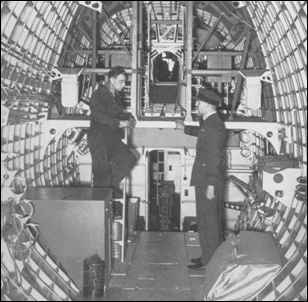 Interior shot, looking forward from the tail.
Interior shot, looking forward from the tail.
The Sunderland Mk.I was powered by four Bristol Pegasus XXII air-cooled radial engines of 1010hp. The fuel for these engines was held in ten self-sealing fuel tanks in the wings, for a total of 2552 gallons (11600 liters). In addition to the guns in the nose and tail turret, the Mk.I had two guns in hatches on the upper aft fuselage. The Mk.II had slightly more powerful Pegasus XVIII engines with constant-speed airscrews, and late in its production run a dorsal gun turret was introduced, replacing the hatches. The Mk.II also carried ASV Mk.II radar . The Pegasus engines and the dorsal turret were retained by the Mk.III, which also had a more streamlined hull with a faired step. This reduced drag, but could cause porpoising during take-off and landing. The Mk.IV was redesigned for operations in the Pacific; it was later renamed Seaford. Only six Seafords were built before the project was cancelled.
The Mk.V had American Pratt & Whitney R-1830-90B engines of 1200hp. Both the Pegasus and the R-1830 were very reliable engines, but the R-1830s had fully-feathering propellers, and in combination with the additional power this significantly increased a chance of a Sunderland to stay airborne with one or two engines out. The Mk.V also had four fixed, forward-firing guns, and two hatches in the aft fuselage for additional guns. The late production Mk.IIIs and the Mk.Vs had centimetric ASV radar. When the war broke out, Coastal Command had 34 Sunderlands in service. Over 700 Sunderlands were built and they served until 1959: 90 Mk.Is, 43 Mk.IIs, 456 Mk.IIIs and 150 Mk.Vs.
The fuselage of the Sunderland was roomy enough to give the crew of ten or more men some comfort on their long patrol flights, which could last up to 13 hours. The front part of the fuselage was divided in two decks. The upper deck contained the cockpit with the two pilots, and the stations for the flight engineer, the wireless operator and the navigator. There was also a compartiment for flares, and positions for the gunners.
On the lower deck there was a bomb room, were bombs or depth charges were stored on movable racks, which were moved to under the wing before an attack. For this purpose there were large rectangular doors under the wings. There was a bomb-aiming position in the nose, below the turret. The bomb load was small for such a large aircraft, but its primary task was reconnaissance. The lower deck also had a wardroom, a galley with two primus stoves and an oven, two bunks for off-duty crewmembers, a flush lavatory, a wash basin, and a shaving mirror. Crews would often collect their own set of dishes and cooking utensils, add curtains to the small wardroom, and install luxuries like a portable radio.
The Sunderland was easy and pleasant to fly, but for long patrols the pilots had the benefit of an autopilot. Its cruising speed was about 225km/h and it usually flew patrols at low altitudes. The main task of many Sunderlands was tracking enemy shipping, flying long patrols over an empty sea. Some crews never saw an enemy in the entire war. The Sunderland also flew search-and-rescue missions. It has to be pointed out that normally, the Sunderland could not land to pick up survivors. Like other flying boats, it could land and take-off only from sheltered coastal waters. From 1942 onwards, landings in open sea were expressly forbidden, except in special circumstances and with permission.
U-boat patrols, carrying eight depth charges, were an important task of the Sunderlands. They patrolled the approaches, or flew convoy protection missions. The two were often combined, with the Sunderlands meeting the convoys at some distance in the ocean. When an U-boat was sighted, the Sunderlands tried to attack it before it submerged. Although described as "depth charges", its bombs were set to explode at a depth of 25 feet to 30 feet, effective enough against surfaced submarines. Late in the war, the submarines were well-armed with Flak and willing to fight it out, while zig-zagging on the surface. In response, the Sunderlands were fitted with four fixed, forward-firing guns, to silence the Flak. The confrontations were extremely dangerous for both the Sunderland and the U-boat. Sunderlands also attacked small surface ships.
The Sunderland was vulnerable to enemy fighters, because it was slow and operated out of the range of Allied fighters. However, the later Sunderlands were well-armed, with nose, dorsal and tail turrets, gun hatches in the aft fuselage, and often some additional guns added by the crews. Flying low above the waves to prevent attacks from below, a Sunderland was not an easy victim, and managed to defend itself very well. For example, in 2 June 1943 a Sunderland survived an attack by eight Ju 88s, shooting down three of them, although it was riddled with holes, lost an engine, and several crewmembers were wounded. Such exploits allegedly earned it the German nickname of "Fliegendes Stachelschwein" (Flying Porcupine), although this could also be attributed to the large array of radar antennas fitted to many Sunderlands.
Perhaps the greatest weakness of the Sunderland was that its range, while significant, was not long enough the close the "mid-Atlantic gap". Coastal Command had to wait for the Liberator to cover the entire Atlantic. But where the Sunderland could operate, it was very effective.
U-boats sunk by this aircraft
1940
U-55 +, U-26 +,
1943
U-465, U-663, U-753 +, U-440, U-563 +, U-607, U-461,
U-383, U-454, U-106 +, U-489, U-610,
1944
U-426, U-571, U-625, U-675, U-955, U-970, U-243,
U-1222, U-385 +, U-270 +, U-107, U-482 +, U-297,
27 U-boats lost to Sunderland aircraft. + means that the Sunderland shared the credit for the sinking.
There is always a very slight chance we might have missed one or two boats in this lookup. If you suspect so please let us know.
Specifications of the Sunderland GR Mk.V
Four 1200hp (895kW) Pratt & Whitney R-1830-90B engines
Wing span 34.38m, length 26.00m, height 10.52m, wing area 156.72m2.
Empty weight 16738kg, maximum take-off weight 29484kg.
Maximum speed 343km/h, ceiling 5455m.
Range 4330km with 757kg bombs.
Armament: ten .303 (7.7mm) guns, two 0.50 (12.7mm) guns, and up to 2250kg of bombs and depth charges.
http://uboat.net/allies/aircraft/sunderland.htm
https://en.wikipedia.org/wiki/Short_Sunderland
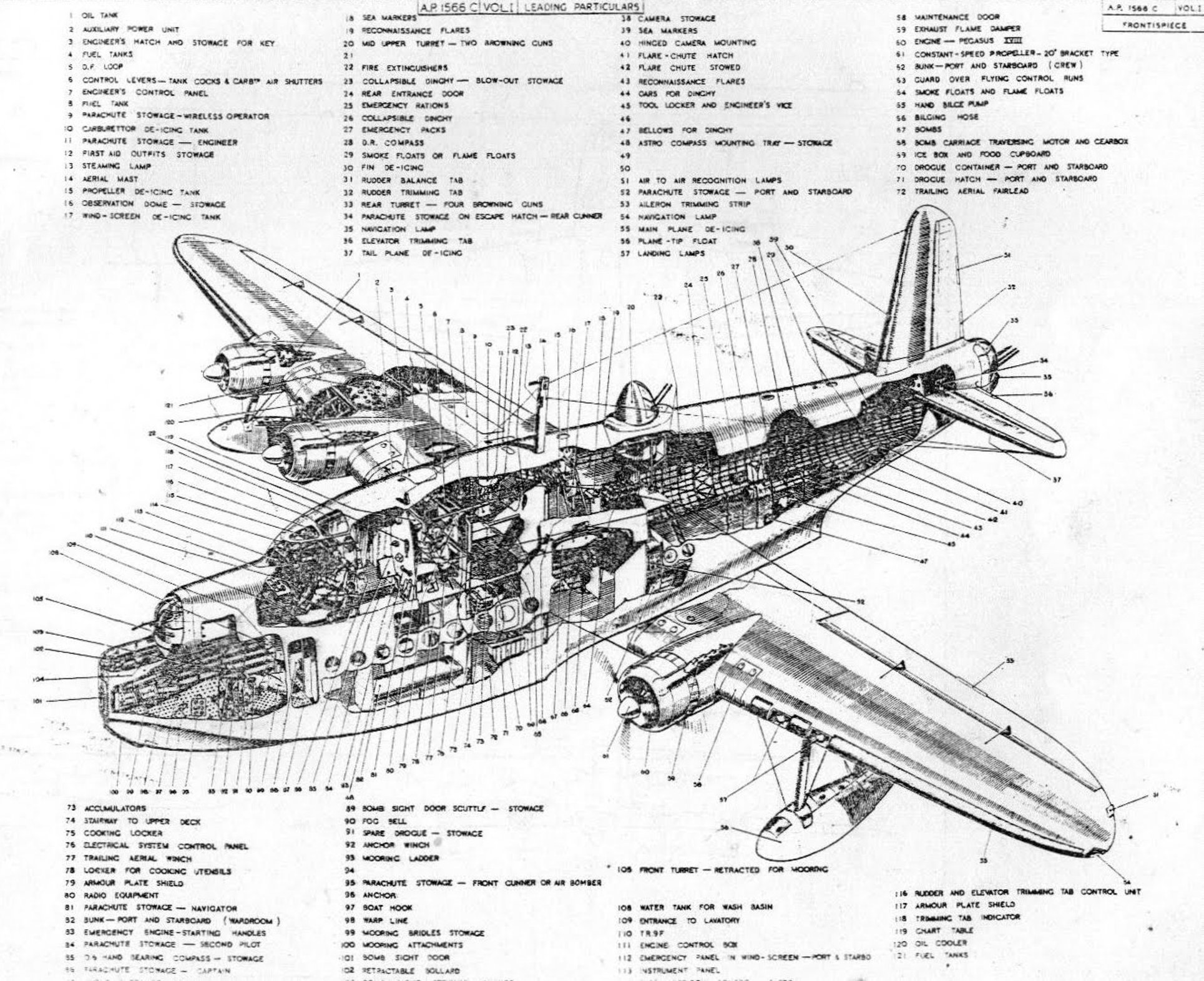
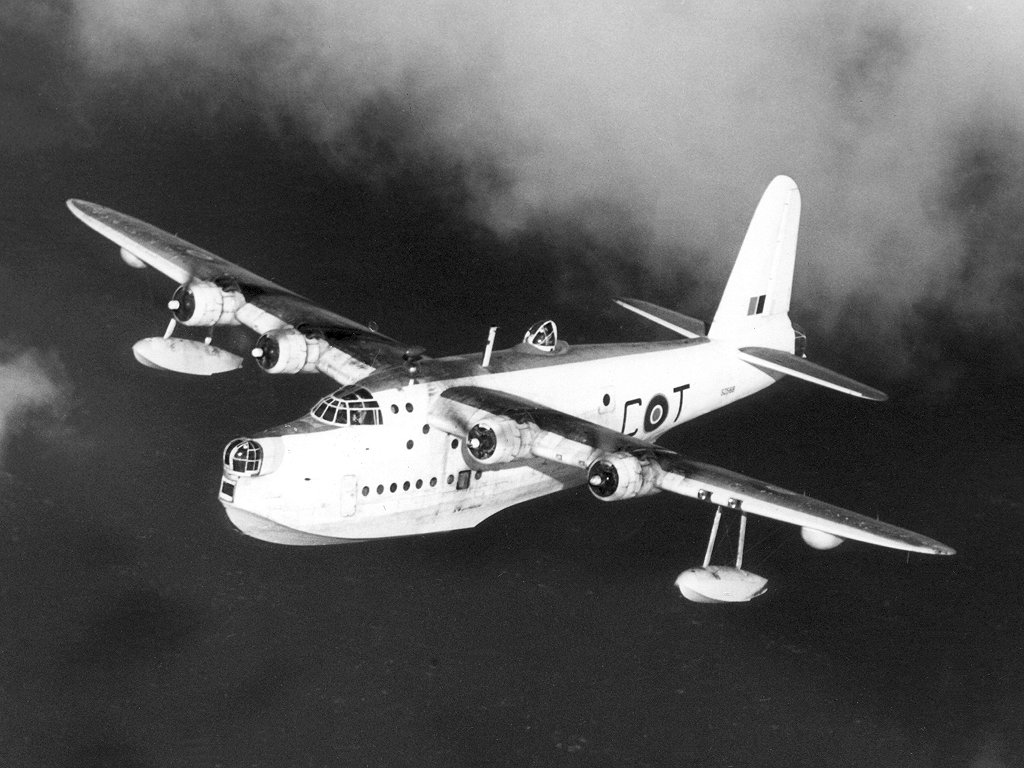
Olen lihavoinut muutaman kiintoisan yksityiskohdan. Muun muassa sillä oli vaikea laskeutua veteen muualla kuin rannikkoalueilla. Wiki tietää kertoa, että avomerellä kyllä pelastettiin koneella väkeä, mutta että jossain vaiheessa se olisi ollut jo kiellettyä.

Tässä tuosta kuuluisasta ilmataistelusta. Lopusta voi lukea, kuinka kävi sitten kaksi kuukautta myöhemmin...
The rifle calibre .303 guns lacked hitting power but the Sunderland's defensive armament was nonetheless formidable. The aircraft's capacity to defend itself was demonstrated in an air battle between eight Junkers Ju 88C long range heavy fighters and a single Sunderland Mark III of No. 461 Squadron RAAF on 2 June 1943. This was one of several stories of the type's operations related by author Ivan Southall, who flew in Sunderlands during the war.[14] There were 11 crewmen on board the Sunderland: nine Australians and two British.[N 1] The aircraft was on an anti-submarine patrol and also searching for remains of BOAC Flight 777, an airliner that had left Lisbon the day before and had subsequently been shot down over the Bay of Biscay, killing 17, among them, the actor Leslie Howard. In the late afternoon, one of the crew spotted the eight Ju 88s. Bombs and depth charges were dumped and the engines brought to maximum power. Two Ju 88s made passes at the flying boat, one from each side, scoring hits and disabling one engine while the Sunderland went through wild "corkscrew" evasive manoeuvres. On the third pass, the dorsal turret gunner shot down a Ju 88. Another Ju 88 disabled the tail turret, but the next one that made a pass was hit by both the dorsal and nose turrets and shot down. Another destroyed the Sunderland's radio gear, wounding most of the crew to varying degrees and mortally wounding one of the side gunners. A Ju 88 tried to attack from the rear, but the tail turret gunner had regained some control over the turret and shot it down. The surviving Ju 88s continued to attack, but the nose gunner damaged one of these, setting its engines on fire. Two more of the attackers were also hit and the final pair disengaged and departed, the only two to make it back to base[citation needed]. The Sunderland had been heavily damaged. The crew threw everything they could overboard and nursed the aircraft back to the Cornish coast, where pilot Colin Walker managed to land and beach the aircraft at Praa Sands. The crew waded ashore, carrying their dead comrade, while the surf broke the Sunderland up. Walker received the Distinguished Service Order and several of the other crew members also received medals. With the exception of Walker, the crew returned to Sunderlands - they disappeared without trace over the Bay of Biscay two months later after reporting that they were under attack by six Ju 88s.
Short Sunderland
prepared by Emmanuel Gustin
To meet requirement R.2/33 of the Air Ministry for a general reconnaissance flying boat, Short developed the S.25 Sunderland from their famous S.23 "Empire" or "C-class" flying boat, the flagship of Imperial Airways. The S.25 first flew on 16 October 1937.
The Sunderland had a deep hull, and the wings were set high on the fuselage, to keep the engines and propellers away from the water spray. For the time, its size was very impressive. The hull had a single step, which served to break the suction of the water, and allow the flying boat to unstick. The characteristic blunt nose contained a two-gun turret, and the tail a four-gun turret. To correct a problem with the center of gravity, the wings were given a slight sweepback; the result was that the engines were slightly toed out. This cost some engine efficiency, but an advantage was that it improved controllability with one engine out. The stabilizing floats under the wing tips were attached by two struts and wire-bracing. On the water the aircraft was steered by canvas drogues, which were deployed through the galley windows.
The Sunderland was a pure flying boat, and if it had to be brought on shore special beaching wheels had to be fitted. Usually the Sunderlands were moored to a buoy. For this purpose, the front gun turret was rolled back and a chain was ran out. An anchor was on board, too. Daily maintenance was performed while the aircraft was moored. Supplies, fuel and ammunition were brought by boats, and some care was required to avoid damaging the hull. It was not uncommon for crews to live in their Sunderland between flights. If the aircraft was moored two men were required to be on board during the night, and during gales a pilot had to be on board because the engines were used to turn the aircraft in the wind. Of course the bilges had to be pumped out regularly, and for this both a manual pump and a pump driven by an Auxiliary Power Unit were installed.

The Sunderland Mk.I was powered by four Bristol Pegasus XXII air-cooled radial engines of 1010hp. The fuel for these engines was held in ten self-sealing fuel tanks in the wings, for a total of 2552 gallons (11600 liters). In addition to the guns in the nose and tail turret, the Mk.I had two guns in hatches on the upper aft fuselage. The Mk.II had slightly more powerful Pegasus XVIII engines with constant-speed airscrews, and late in its production run a dorsal gun turret was introduced, replacing the hatches. The Mk.II also carried ASV Mk.II radar . The Pegasus engines and the dorsal turret were retained by the Mk.III, which also had a more streamlined hull with a faired step. This reduced drag, but could cause porpoising during take-off and landing. The Mk.IV was redesigned for operations in the Pacific; it was later renamed Seaford. Only six Seafords were built before the project was cancelled.
The Mk.V had American Pratt & Whitney R-1830-90B engines of 1200hp. Both the Pegasus and the R-1830 were very reliable engines, but the R-1830s had fully-feathering propellers, and in combination with the additional power this significantly increased a chance of a Sunderland to stay airborne with one or two engines out. The Mk.V also had four fixed, forward-firing guns, and two hatches in the aft fuselage for additional guns. The late production Mk.IIIs and the Mk.Vs had centimetric ASV radar. When the war broke out, Coastal Command had 34 Sunderlands in service. Over 700 Sunderlands were built and they served until 1959: 90 Mk.Is, 43 Mk.IIs, 456 Mk.IIIs and 150 Mk.Vs.
The fuselage of the Sunderland was roomy enough to give the crew of ten or more men some comfort on their long patrol flights, which could last up to 13 hours. The front part of the fuselage was divided in two decks. The upper deck contained the cockpit with the two pilots, and the stations for the flight engineer, the wireless operator and the navigator. There was also a compartiment for flares, and positions for the gunners.
On the lower deck there was a bomb room, were bombs or depth charges were stored on movable racks, which were moved to under the wing before an attack. For this purpose there were large rectangular doors under the wings. There was a bomb-aiming position in the nose, below the turret. The bomb load was small for such a large aircraft, but its primary task was reconnaissance. The lower deck also had a wardroom, a galley with two primus stoves and an oven, two bunks for off-duty crewmembers, a flush lavatory, a wash basin, and a shaving mirror. Crews would often collect their own set of dishes and cooking utensils, add curtains to the small wardroom, and install luxuries like a portable radio.
The Sunderland was easy and pleasant to fly, but for long patrols the pilots had the benefit of an autopilot. Its cruising speed was about 225km/h and it usually flew patrols at low altitudes. The main task of many Sunderlands was tracking enemy shipping, flying long patrols over an empty sea. Some crews never saw an enemy in the entire war. The Sunderland also flew search-and-rescue missions. It has to be pointed out that normally, the Sunderland could not land to pick up survivors. Like other flying boats, it could land and take-off only from sheltered coastal waters. From 1942 onwards, landings in open sea were expressly forbidden, except in special circumstances and with permission.
U-boat patrols, carrying eight depth charges, were an important task of the Sunderlands. They patrolled the approaches, or flew convoy protection missions. The two were often combined, with the Sunderlands meeting the convoys at some distance in the ocean. When an U-boat was sighted, the Sunderlands tried to attack it before it submerged. Although described as "depth charges", its bombs were set to explode at a depth of 25 feet to 30 feet, effective enough against surfaced submarines. Late in the war, the submarines were well-armed with Flak and willing to fight it out, while zig-zagging on the surface. In response, the Sunderlands were fitted with four fixed, forward-firing guns, to silence the Flak. The confrontations were extremely dangerous for both the Sunderland and the U-boat. Sunderlands also attacked small surface ships.
The Sunderland was vulnerable to enemy fighters, because it was slow and operated out of the range of Allied fighters. However, the later Sunderlands were well-armed, with nose, dorsal and tail turrets, gun hatches in the aft fuselage, and often some additional guns added by the crews. Flying low above the waves to prevent attacks from below, a Sunderland was not an easy victim, and managed to defend itself very well. For example, in 2 June 1943 a Sunderland survived an attack by eight Ju 88s, shooting down three of them, although it was riddled with holes, lost an engine, and several crewmembers were wounded. Such exploits allegedly earned it the German nickname of "Fliegendes Stachelschwein" (Flying Porcupine), although this could also be attributed to the large array of radar antennas fitted to many Sunderlands.
Perhaps the greatest weakness of the Sunderland was that its range, while significant, was not long enough the close the "mid-Atlantic gap". Coastal Command had to wait for the Liberator to cover the entire Atlantic. But where the Sunderland could operate, it was very effective.
U-boats sunk by this aircraft
1940
U-55 +, U-26 +,
1943
U-465, U-663, U-753 +, U-440, U-563 +, U-607, U-461,
U-383, U-454, U-106 +, U-489, U-610,
1944
U-426, U-571, U-625, U-675, U-955, U-970, U-243,
U-1222, U-385 +, U-270 +, U-107, U-482 +, U-297,
27 U-boats lost to Sunderland aircraft. + means that the Sunderland shared the credit for the sinking.
There is always a very slight chance we might have missed one or two boats in this lookup. If you suspect so please let us know.
Specifications of the Sunderland GR Mk.V
Four 1200hp (895kW) Pratt & Whitney R-1830-90B engines
Wing span 34.38m, length 26.00m, height 10.52m, wing area 156.72m2.
Empty weight 16738kg, maximum take-off weight 29484kg.
Maximum speed 343km/h, ceiling 5455m.
Range 4330km with 757kg bombs.
Armament: ten .303 (7.7mm) guns, two 0.50 (12.7mm) guns, and up to 2250kg of bombs and depth charges.
http://uboat.net/allies/aircraft/sunderland.htm
https://en.wikipedia.org/wiki/Short_Sunderland


tulikomento
Supreme Leader
Short Sunderland oli yksi suosikeistani Korkkareissa. Viimeiset mallit olivat jo niin vahvasti aseistettuja, että yksi piti 1943 puoliaan kahdeksaan JU-88:a vastaan, ja ampui niistä kolme alas! Tosisotilaita siinä lentoveneessä.
Olen lihavoinut muutaman kiintoisan yksityiskohdan. Muun muassa sillä oli vaikea laskeutua veteen muualla kuin rannikkoalueilla. Wiki tietää kertoa, että avomerellä kyllä pelastettiin koneella väkeä, mutta että jossain vaiheessa se olisi ollut jo kiellettyä.

Tässä tuosta kuuluisasta ilmataistelusta. Lopusta voi lukea, kuinka kävi sitten kaksi kuukautta myöhemmin...
The rifle calibre .303 guns lacked hitting power but the Sunderland's defensive armament was nonetheless formidable. The aircraft's capacity to defend itself was demonstrated in an air battle between eight Junkers Ju 88C long range heavy fighters and a single Sunderland Mark III of No. 461 Squadron RAAF on 2 June 1943. This was one of several stories of the type's operations related by author Ivan Southall, who flew in Sunderlands during the war.[14] There were 11 crewmen on board the Sunderland: nine Australians and two British.[N 1] The aircraft was on an anti-submarine patrol and also searching for remains of BOAC Flight 777, an airliner that had left Lisbon the day before and had subsequently been shot down over the Bay of Biscay, killing 17, among them, the actor Leslie Howard. In the late afternoon, one of the crew spotted the eight Ju 88s. Bombs and depth charges were dumped and the engines brought to maximum power. Two Ju 88s made passes at the flying boat, one from each side, scoring hits and disabling one engine while the Sunderland went through wild "corkscrew" evasive manoeuvres. On the third pass, the dorsal turret gunner shot down a Ju 88. Another Ju 88 disabled the tail turret, but the next one that made a pass was hit by both the dorsal and nose turrets and shot down. Another destroyed the Sunderland's radio gear, wounding most of the crew to varying degrees and mortally wounding one of the side gunners. A Ju 88 tried to attack from the rear, but the tail turret gunner had regained some control over the turret and shot it down. The surviving Ju 88s continued to attack, but the nose gunner damaged one of these, setting its engines on fire. Two more of the attackers were also hit and the final pair disengaged and departed, the only two to make it back to base[citation needed]. The Sunderland had been heavily damaged. The crew threw everything they could overboard and nursed the aircraft back to the Cornish coast, where pilot Colin Walker managed to land and beach the aircraft at Praa Sands. The crew waded ashore, carrying their dead comrade, while the surf broke the Sunderland up. Walker received the Distinguished Service Order and several of the other crew members also received medals. With the exception of Walker, the crew returned to Sunderlands - they disappeared without trace over the Bay of Biscay two months later after reporting that they were under attack by six Ju 88s.

Short Sunderland
prepared by Emmanuel Gustin
To meet requirement R.2/33 of the Air Ministry for a general reconnaissance flying boat, Short developed the S.25 Sunderland from their famous S.23 "Empire" or "C-class" flying boat, the flagship of Imperial Airways. The S.25 first flew on 16 October 1937.
The Sunderland had a deep hull, and the wings were set high on the fuselage, to keep the engines and propellers away from the water spray. For the time, its size was very impressive. The hull had a single step, which served to break the suction of the water, and allow the flying boat to unstick. The characteristic blunt nose contained a two-gun turret, and the tail a four-gun turret. To correct a problem with the center of gravity, the wings were given a slight sweepback; the result was that the engines were slightly toed out. This cost some engine efficiency, but an advantage was that it improved controllability with one engine out. The stabilizing floats under the wing tips were attached by two struts and wire-bracing. On the water the aircraft was steered by canvas drogues, which were deployed through the galley windows.
The Sunderland was a pure flying boat, and if it had to be brought on shore special beaching wheels had to be fitted. Usually the Sunderlands were moored to a buoy. For this purpose, the front gun turret was rolled back and a chain was ran out. An anchor was on board, too. Daily maintenance was performed while the aircraft was moored. Supplies, fuel and ammunition were brought by boats, and some care was required to avoid damaging the hull. It was not uncommon for crews to live in their Sunderland between flights. If the aircraft was moored two men were required to be on board during the night, and during gales a pilot had to be on board because the engines were used to turn the aircraft in the wind. Of course the bilges had to be pumped out regularly, and for this both a manual pump and a pump driven by an Auxiliary Power Unit were installed.
Interior shot, looking forward from the tail.
The Sunderland Mk.I was powered by four Bristol Pegasus XXII air-cooled radial engines of 1010hp. The fuel for these engines was held in ten self-sealing fuel tanks in the wings, for a total of 2552 gallons (11600 liters). In addition to the guns in the nose and tail turret, the Mk.I had two guns in hatches on the upper aft fuselage. The Mk.II had slightly more powerful Pegasus XVIII engines with constant-speed airscrews, and late in its production run a dorsal gun turret was introduced, replacing the hatches. The Mk.II also carried ASV Mk.II radar . The Pegasus engines and the dorsal turret were retained by the Mk.III, which also had a more streamlined hull with a faired step. This reduced drag, but could cause porpoising during take-off and landing. The Mk.IV was redesigned for operations in the Pacific; it was later renamed Seaford. Only six Seafords were built before the project was cancelled.
The Mk.V had American Pratt & Whitney R-1830-90B engines of 1200hp. Both the Pegasus and the R-1830 were very reliable engines, but the R-1830s had fully-feathering propellers, and in combination with the additional power this significantly increased a chance of a Sunderland to stay airborne with one or two engines out. The Mk.V also had four fixed, forward-firing guns, and two hatches in the aft fuselage for additional guns. The late production Mk.IIIs and the Mk.Vs had centimetric ASV radar. When the war broke out, Coastal Command had 34 Sunderlands in service. Over 700 Sunderlands were built and they served until 1959: 90 Mk.Is, 43 Mk.IIs, 456 Mk.IIIs and 150 Mk.Vs.
The fuselage of the Sunderland was roomy enough to give the crew of ten or more men some comfort on their long patrol flights, which could last up to 13 hours. The front part of the fuselage was divided in two decks. The upper deck contained the cockpit with the two pilots, and the stations for the flight engineer, the wireless operator and the navigator. There was also a compartiment for flares, and positions for the gunners.
On the lower deck there was a bomb room, were bombs or depth charges were stored on movable racks, which were moved to under the wing before an attack. For this purpose there were large rectangular doors under the wings. There was a bomb-aiming position in the nose, below the turret. The bomb load was small for such a large aircraft, but its primary task was reconnaissance. The lower deck also had a wardroom, a galley with two primus stoves and an oven, two bunks for off-duty crewmembers, a flush lavatory, a wash basin, and a shaving mirror. Crews would often collect their own set of dishes and cooking utensils, add curtains to the small wardroom, and install luxuries like a portable radio.
The Sunderland was easy and pleasant to fly, but for long patrols the pilots had the benefit of an autopilot. Its cruising speed was about 225km/h and it usually flew patrols at low altitudes. The main task of many Sunderlands was tracking enemy shipping, flying long patrols over an empty sea. Some crews never saw an enemy in the entire war. The Sunderland also flew search-and-rescue missions. It has to be pointed out that normally, the Sunderland could not land to pick up survivors. Like other flying boats, it could land and take-off only from sheltered coastal waters. From 1942 onwards, landings in open sea were expressly forbidden, except in special circumstances and with permission.
U-boat patrols, carrying eight depth charges, were an important task of the Sunderlands. They patrolled the approaches, or flew convoy protection missions. The two were often combined, with the Sunderlands meeting the convoys at some distance in the ocean. When an U-boat was sighted, the Sunderlands tried to attack it before it submerged. Although described as "depth charges", its bombs were set to explode at a depth of 25 feet to 30 feet, effective enough against surfaced submarines. Late in the war, the submarines were well-armed with Flak and willing to fight it out, while zig-zagging on the surface. In response, the Sunderlands were fitted with four fixed, forward-firing guns, to silence the Flak. The confrontations were extremely dangerous for both the Sunderland and the U-boat. Sunderlands also attacked small surface ships.
The Sunderland was vulnerable to enemy fighters, because it was slow and operated out of the range of Allied fighters. However, the later Sunderlands were well-armed, with nose, dorsal and tail turrets, gun hatches in the aft fuselage, and often some additional guns added by the crews. Flying low above the waves to prevent attacks from below, a Sunderland was not an easy victim, and managed to defend itself very well. For example, in 2 June 1943 a Sunderland survived an attack by eight Ju 88s, shooting down three of them, although it was riddled with holes, lost an engine, and several crewmembers were wounded. Such exploits allegedly earned it the German nickname of "Fliegendes Stachelschwein" (Flying Porcupine), although this could also be attributed to the large array of radar antennas fitted to many Sunderlands.
Perhaps the greatest weakness of the Sunderland was that its range, while significant, was not long enough the close the "mid-Atlantic gap". Coastal Command had to wait for the Liberator to cover the entire Atlantic. But where the Sunderland could operate, it was very effective.
U-boats sunk by this aircraft
1940
U-55 +, U-26 +,
1943
U-465, U-663, U-753 +, U-440, U-563 +, U-607, U-461,
U-383, U-454, U-106 +, U-489, U-610,
1944
U-426, U-571, U-625, U-675, U-955, U-970, U-243,
U-1222, U-385 +, U-270 +, U-107, U-482 +, U-297,
27 U-boats lost to Sunderland aircraft. + means that the Sunderland shared the credit for the sinking.
There is always a very slight chance we might have missed one or two boats in this lookup. If you suspect so please let us know.
Specifications of the Sunderland GR Mk.V
Four 1200hp (895kW) Pratt & Whitney R-1830-90B engines
Wing span 34.38m, length 26.00m, height 10.52m, wing area 156.72m2.
Empty weight 16738kg, maximum take-off weight 29484kg.
Maximum speed 343km/h, ceiling 5455m.
Range 4330km with 757kg bombs.
Armament: ten .303 (7.7mm) guns, two 0.50 (12.7mm) guns, and up to 2250kg of bombs and depth charges.
http://uboat.net/allies/aircraft/sunderland.htm
https://en.wikipedia.org/wiki/Short_Sunderland

"Lentävä piikkisika" löytyisi Royal Air Forcen museosta Lontoosta.
http://www.rafmuseum.org.uk/research/collections/short-sunderland-mr5/
Miten olis pojat, joskus tehtäisiin porukalla pyhiinvaellusreissu saarivaltakunnan pääkaupunkiin ? Ohjelmistossa RAF:n erinomainen museo, loistava Imperial War Museum ja perusteellista tutustumista engelsmannien pubikulttuuriin ?
JR49
Respected Leader
Kannatetaan. Mutta mites se jäi se kotimainen ilmailunäytös kesällä, siirtyikös sen aikataulu? Siellähän näitä kohteita voisi lyödä kartalle."Lentävä piikkisika" löytyisi Royal Air Forcen museosta Lontoosta.
http://www.rafmuseum.org.uk/research/collections/short-sunderland-mr5/
Miten olis pojat, joskus tehtäisiin porukalla pyhiinvaellusreissu saarivaltakunnan pääkaupunkiin ? Ohjelmistossa RAF:n erinomainen museo, loistava Imperial War Museum ja perusteellista tutustumista engelsmannien pubikulttuuriin ?
Loppuillasta kartta vaan olisi täynnä nuppineuloja ja oluen tahrima..
tulikomento
Supreme Leader
Kannatetaan. Mutta mites se jäi se kotimainen ilmailunäytös kesällä, siirtyikös sen aikataulu? Siellähän näitä kohteita voisi lyödä kartalle.
Loppuillasta kartta vaan olisi täynnä nuppineuloja ja oluen tahrima..
2016 päänäytös olis Kuopiossa. Muistaakseni kesäkuussa.
JR49
Respected Leader
Hyvä. Tunnen kaupungin. Takaan, että mukaani lähtevä joukko etenee aamuyöstä tukevasti nelinkontin hyvän ruoan ja laatuviinaksien painosta.2016 päänäytös olis Kuopiossa. Muistaakseni kesäkuussa.
Sarek1
Ylipäällikkö
"Lentävä piikkisika" löytyisi Royal Air Forcen museosta Lontoosta.
http://www.rafmuseum.org.uk/research/collections/short-sunderland-mr5/
Miten olis pojat, joskus tehtäisiin porukalla pyhiinvaellusreissu saarivaltakunnan pääkaupunkiin ? Ohjelmistossa RAF:n erinomainen museo, loistava Imperial War Museum ja perusteellista tutustumista engelsmannien pubikulttuuriin ?
Olen käynyt perhematkailun puitteissa (myönnytyksenä koluttiin kaikki ihanat merkkiliikkeet joissa oli tietysti ale...) ja katsottavaa sieltä kyllä löytyy.
Ilmailufaneille suosittelen vilpittömästi pyhiinvaellusmatkaa Duxfordiin ja jos ajoitus sopii niin etenkin silloin kun siellä myös lennetään näytöksiä. Itse en ole vielä ikävä kyllä sattunut paikalle tuolloin mutta esim. Parolan panssarimuseossa perinnepäivänä käyneenä voin kuvitella eron tavanomaiseen. Duxfordissa on paljon lentokoneita mutta runsaasti myös muuta sotanähtävää. Vanhin kupeitten hedelmä kolusi nuo Lontoon parhaat kohteet ja Duxfordin viime kesänä uudelleen kaverinsa kanssa ja kyllähän sieltä mukavia kuvia ja selfieitä tuli sarjatulella "vasa-nappiin".
Näytöksissä on se paha puoli, että niiden seuraamiseen menee niin paljon aikaa, ettei silloin ehdi koko laajaa museota kiertämään, mutta kyllä ne näytökset ovat näkemisen arvoisia, julkisilla kannattaa mennä, vuokra-autolla käydessä meni aikaa jonkun verran moottoritiellä seistessä ja sitten parkkipaikkaa etsiessä. Näytöksistähän on DVD:itä myynnissä.
Liitteet
Sarek1
Ylipäällikkö
@Juha_ on oikeassa siinä, että nähtävää Duxfordissa on paljon ja että näytöspäivänä kaikkea ei ehdi välttämättä kiertää museopuolella läpi. Myös liikenneohje on sellainen jota komppaan täysillä. Jos haluaa olla näytöksessä ja katsella rauhassa museopuolen läpi, voi olla hyvä varata kaksi päivää ja yöpyä lähistöllä (Duxford, Cambridge...). Individual preferences may vary.
Lontoon kohteissa ollaan menty nähtävyys- ja museokierroksissa omalla perheellä yleensä max 2 pääkohdetta /päivä -tahdilla. Jotkut kohteista voivat olla sellaisia että niissä voisi vierähtää useampikin päivä, mutta silloin ollaan palasteltu vähän ja keskitytty kulloinkin kiinnostavimpiin asioihin. Jos liikutte lasten kanssa, suosittelen Natural History Museumissa ja vieressä sijaitsevassa tiedemuseossa käymistä. Alle kilometrin päässä on sitten vaimoväkeä kiinnostava Harrods ja matkalla sinne monta muutakin atrappia... Metro on ehdottomasti kätevin kulkuväline siirtymissä ellei halua fiilistellä nähtävyyskierroksilla.
Juha_n viestiin liitetty kuva on suorastaan vastustamattoman hunajaista houkutusta niille, jotka ovat päässeet ulkoilmassa osallisiksi Merlin-moottorin upeasta murinasta ja ujelluksesta.
---
Jotta ei aivan OT:ksi menisi niin laitetaan pommari. Erikoisen näköinen vekotin, joka ei tullut tuotantoon. Lähde Soviet Combat Aircraft of the Second World War, vol.2



Lontoon kohteissa ollaan menty nähtävyys- ja museokierroksissa omalla perheellä yleensä max 2 pääkohdetta /päivä -tahdilla. Jotkut kohteista voivat olla sellaisia että niissä voisi vierähtää useampikin päivä, mutta silloin ollaan palasteltu vähän ja keskitytty kulloinkin kiinnostavimpiin asioihin. Jos liikutte lasten kanssa, suosittelen Natural History Museumissa ja vieressä sijaitsevassa tiedemuseossa käymistä. Alle kilometrin päässä on sitten vaimoväkeä kiinnostava Harrods ja matkalla sinne monta muutakin atrappia... Metro on ehdottomasti kätevin kulkuväline siirtymissä ellei halua fiilistellä nähtävyyskierroksilla.
Juha_n viestiin liitetty kuva on suorastaan vastustamattoman hunajaista houkutusta niille, jotka ovat päässeet ulkoilmassa osallisiksi Merlin-moottorin upeasta murinasta ja ujelluksesta.
---
Jotta ei aivan OT:ksi menisi niin laitetaan pommari. Erikoisen näköinen vekotin, joka ei tullut tuotantoon. Lähde Soviet Combat Aircraft of the Second World War, vol.2



Viimeksi muokattu:
tulikomento
Supreme Leader
Jokos tämä uutinen on ollut täällä ?
B-29 Superfortress "Doc" nousee toivon mukaan siivilleen Amerikassa, jolloin siitä tulee maailman toinen lentokelpoinen B-29 "Fifin" jälkeen.
http://www.b-29doc.com/
Ilmeisesti fyffeä on saatu lahjoittajilta kasaan riittävä määrä koelento-ohjelmaa varten. Ensilentoa ei kuitenkaan ole voitu suorittaa ja vapaan hallitilan puuttuessa "Doc" joutuu odottamaan ulkona.
http://www.avweb.com/avwebflash/news/No-Room-In-The-Hangars-For-Doc-225427-1.html
Toivottavasti tämä hienolta vaikuttava kunnostusprojekti onnistuu !


B-29 Superfortress "Doc" nousee toivon mukaan siivilleen Amerikassa, jolloin siitä tulee maailman toinen lentokelpoinen B-29 "Fifin" jälkeen.
http://www.b-29doc.com/
Ilmeisesti fyffeä on saatu lahjoittajilta kasaan riittävä määrä koelento-ohjelmaa varten. Ensilentoa ei kuitenkaan ole voitu suorittaa ja vapaan hallitilan puuttuessa "Doc" joutuu odottamaan ulkona.
http://www.avweb.com/avwebflash/news/No-Room-In-The-Hangars-For-Doc-225427-1.html
Toivottavasti tämä hienolta vaikuttava kunnostusprojekti onnistuu !




